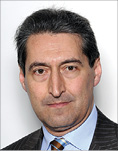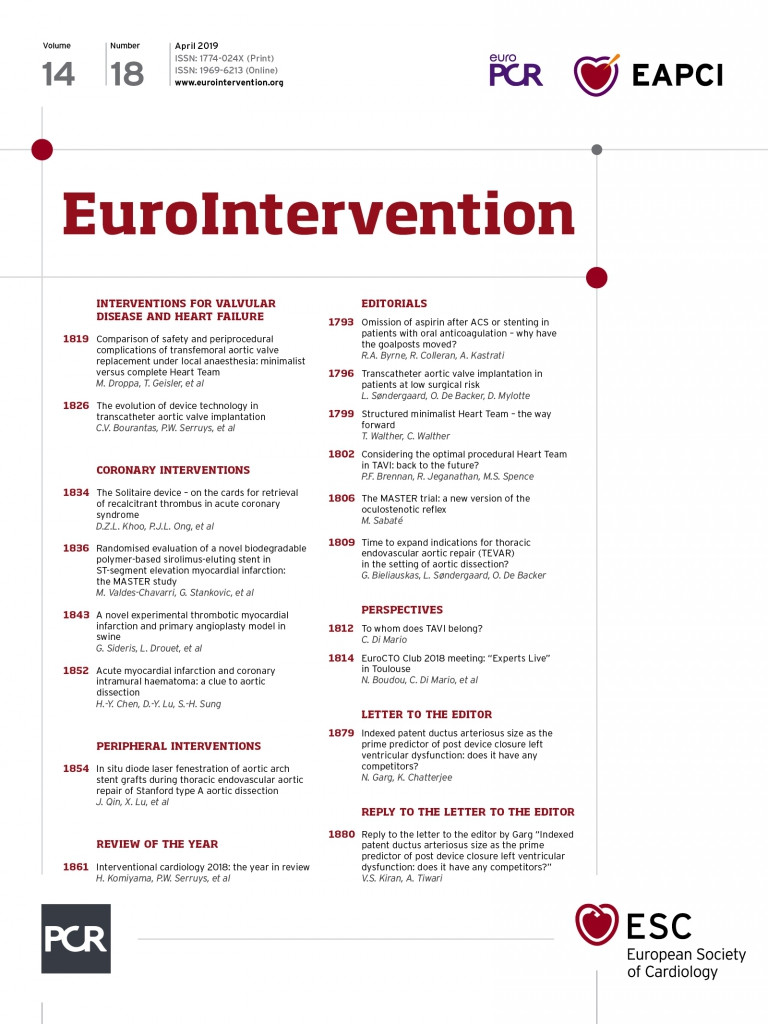
When transcatheter aortic valve implantation (TAVI) took off 10 years ago, many thought that this question was never going to be asked. Nearly half of TAVIs were performed using a surgical approach, often transapical, new promising surgical routes were developing (transaortic, trans-subclavian), and there was a small but not negligible risk of surgical conversion. A cardiac surgeon and an interventional cardiologist working together was the most logical option. At the time, TAVI was an appealing option for inoperable or high-risk patients, but residual aortic regurgitation, high pacemaker implantation, and doubts on long-term durability limited its application to a minority of the existing candidates for surgical aortic valve replacement (SAVR). Structural interventionalists are now victims of their own success, having generated convincing evidence that transfemoral TAVI is equal to or better than TAVI through other routes or SAVR in most intermediate-risk and, after the presentation of the PARTNER-3 data, also in low-risk patients. With smaller delivery catheters, iliac lithotripsy for calcified iliac arteries and novel fully percutaneous approaches (transcaval, transaxillary), many of the 10-15% of poor transfemoral TAVI candidates are also unlikely to require the help of surgeons for the vascular access in the near future.
With most TAVI procedures independently performed transfemorally by interventional cardiologists, the gentlemanly attitude of the first Heart Teams of 10 years ago is long gone in many centres. Dogmatic interpretations of the guidelines with mistrust of the presented clinical findings and calculated scores often transform these events from occasions of growth and open patient-oriented discussion for the entire team into unpleasant events resembling the demagogic shows of modern politics.
The next step, possibly with more disrupting consequences for interventional cardiology, is the decision of many cardiac surgeons to start separate transfemoral TAVI programmes. Typically, this does not happen in centres with an established TAVI tradition where a few forward-looking surgeons embarked from the start on these novel procedures, already developing interventional skills. Nobody questions their right to remain protagonists of the further increase in TAVI indications and improvement in techniques. It is in centres where TAVI was marginalised with low numbers for years that we now see surgeons who were publicly denigrating TAVI till just the day before suddenly waking up and claiming TAVI for their own, seeing it as just another minimally invasive approach to valve surgery.
The first impulse is to disregard these attempts as late laughable repentance, unlikely to have an impact on well-developed interventional TAVI programmes. TAVI was begun by Alain Cribier, an interventional cardiologist, and the leadership of these programmes (heavily reliant on cath lab-based catheter skills) seems a logical prerogative of cardiology. However, let us examine the problem from the viewpoint of a cardiac surgeon. Advanced valve disease was their unchallenged field for decades. They are already facing a decrease in the numbers of coronary artery bypass surgery thanks to improved prevention and rapid access to coronary stents for acute coronary syndromes, now the most frequent indication for myocardial revascularisation. When attending those joint congresses that highlight the Heart Team, cardiac surgeons watch cases of TAVI in young patients with bicuspid aortic valves, or they see fully percutaneous techniques for transseptal mitral valve replacement or repair, and it is only natural for them to ask what is left for surgery. At the dawn of the drug-eluting stent (DES) era 15 years ago they were hurt by distasteful cartoons showing surgeons begging in the streets holding signs saying “I will operate for food”. This proved to be wrong, but they do not want to take similar risks for valves and they are desperate to find remedies.
I am old enough to have lived through the enthusiasm created by CABG surgery in multivessel and left main disease, to have admired valve surgeons perfecting the techniques of valve repair, to have marvelled at the ability to replace or repair a valve or skeletonise and implant a mammary with 2-3 cm of residual chest scar. New high-performance left ventricular assist devices now offer hope to advanced heart failure patients. The surgical factories of 10 to 20 years ago might be over but cardiac surgery will not die; on the contrary, it is opening new fields of application and falling absolute numbers offer more time to refine techniques and respond to the general demand to reduce invasiveness. Is it truly necessary that, as an indispensable part of the process leading to less invasive methods, all cardiac surgeons irrespective of their age start learning and practising fully percutaneous TAVI? As a loyal customer referring many patients throughout my career, let me respectfully disagree. For those senior cardiac surgeons who might already be subspecialised in mitral repair or aortic root surgery, adding TAVI will dilute their expertise in activities that require special skills as well as years of practice to learn and a continuous workload to maintain. My advice might be different for young cardiac surgeons or fellows in training. According to their starting level and the country’s academic rules for training, many options are possible: modifications of the curriculum of cardiac surgery, master courses in transcatheter structural interventions, participation in joint teams led by expert structural interventionalists. Certainly the wrong choice is to pretend that a doctor who can perform complex surgery is automatically capable of implanting transcatheter valves after just a few days spent playing on simulators or assembling a valve delivery system. Another foolish choice is to call in outside proctors to correct the inevitable mistakes of beginners when specialists with years of experience work 50 metres away.
Professional societies, such as the EAPCI and EACTS under the common umbrella of the ESC, should prepare consensus documents on TAVI training. The goal is to dispel any mistrust and avoid conflicts by providing a clear definition of roles, drawing optimal training paths in the exclusive interest of optimal patient care.
To whom does TAVI belong? Like all techniques and craftsmanship, it is not the sole property of a specific group which can forbid others from practising it, like the guilds of the Middle Ages. It belongs to patients who have the right to have it performed by professionals with the best experience in a relaxed athmospere of healthy cooperation, pooling together the specific capabilities of all the members of the team.
Conflict of interest statement
C. Di Mario reports research grants to his institution from Edwards and Medtronic.

